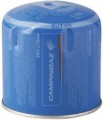Connection
Method of connecting the cylinder with the burner. This is one of the main criteria for choosing a gas cylinder: the type of connection must match the one provided in the burner.
—
Threaded (epi-gas). A variant also known as "European carving". A classic threaded connection, characterized by good reliability and allowing you to remove the cylinder before the gas supply is used up.
—
collet. Cylinders with such a connection are also called stock, fitting, and colloquially — "dichlorvos" (because such a container resembles an aerosol can with a spray cap removed). A thin tube (rod) is responsible for the connection, clamped in the collet during installation. This option is popular mainly among tourist gas stoves, which have a recess in the case for a cylinder — if the cylinder is located remotely, the connection would not be very reliable. The cylinders themselves often have thinner walls than other connection types, requiring care in handling.
—
Valve (Easy Click). Type of connection used mainly in Campingaz and Coleman burners. This mount is easier and faster to connect/disconnect than a threaded mount, while being considered more secure and leak-proof.
—
puncture. In accordance with the name, with this connection, the cylinder shell is pierced. Such tanks are intended mainly for domestic use —
...at picnics, summer cottages, in long-term camps, etc. This is due to the fact that the cylinder cannot be disconnected from the burner until the gas is completely used up. On the other hand, puncture models are extremely simple and inexpensive.
The same type of connection from different manufacturers may have different sizes and design features. Therefore, when buying, it is advisable to specify not only this parameter, but also the compatibility of the cylinder with a specific burner model (especially if the burner and tank are from different manufacturers). Also note that for tanks for liquid fuels (see "Type") the type of connection is not indicated at all — they are usually made for stoves of a particular brand.Composition of the mixture
The composition of the fuel initially filled into the tank.
This option is relevant primarily for gas cylinders (see "Type"). In them, different mixtures will differ primarily in the temperature regime of operation (see below). They can also have different temperatures and specific heat of combustion, but this difference is not very large, and when used for its main purpose (cooking, heating water) it is almost imperceptible. Therefore, it makes sense to pay attention to the composition if the cylinder is planned to be used in cold conditions — in winter or in the highlands — or for specific purposes (for example, some models allow installation in a blowtorch). If there is no question of such use, then the composition of the mixture practically does not play a role (except that it is worth considering that branded “winter” grades of fuel are more expensive than “ordinary” ones).
Detailed data on various compositions of the mixture, if desired, can be found in special sources.
Net weight
The weight of the fuel filled into the cylinder, excluding the tank itself. Knowing the approximate fuel consumption in the burner, this parameter can be used to estimate how much the reserve in the cylinder will last. The weight of the tank itself is rather small compared to the weight of the fuel, and can usually be neglected when calculating the total weight of the luggage.
